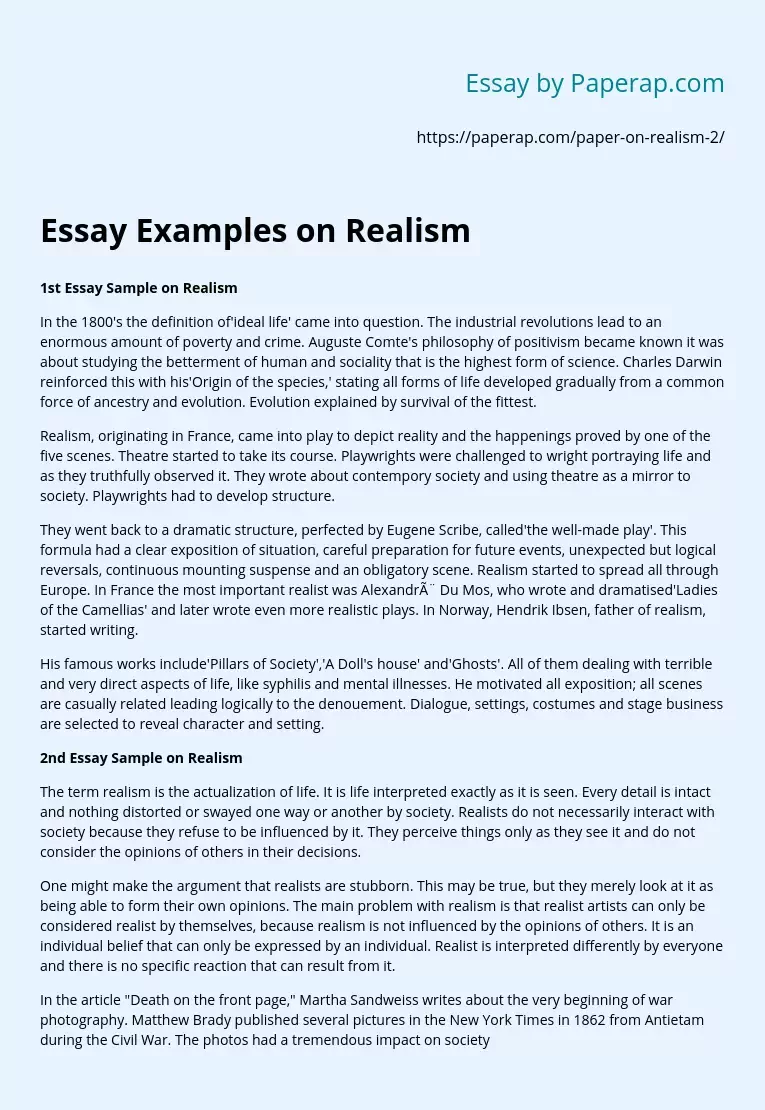Essay Examples on Realism
1st Essay Sample on Realism
In the 1800’s the definition of’ideal life’ came into question. The industrial revolutions lead to an enormous amount of poverty and crime. Auguste Comte’s philosophy of positivism became known it was about studying the betterment of human and sociality that is the highest form of science. Charles Darwin reinforced this with his’Origin of the species,’ stating all forms of life developed gradually from a common force of ancestry and evolution. Evolution explained by survival of the fittest.
Realism, originating in France, came into play to depict reality and the happenings proved by one of the five scenes. Theatre started to take its course. Playwrights were challenged to wright portraying life and as they truthfully observed it. They wrote about contempory society and using theatre as a mirror to society. Playwrights had to develop structure.
They went back to a dramatic structure, perfected by Eugene Scribe, called’the well-made play’. This formula had a clear exposition of situation, careful preparation for future events, unexpected but logical reversals, continuous mounting suspense and an obligatory scene.
Realism started to spread all through Europe. In France the most important realist was Alexandrè Du Mos, who wrote and dramatised’Ladies of the Camellias’ and later wrote even more realistic plays. In Norway, Hendrik Ibsen, father of realism, started writing.
His famous works include’Pillars of Society’,’A Doll’s house’ and’Ghosts’. All of them dealing with terrible and very direct aspects of life, like syphilis and mental illnesses.
He motivated all exposition; all scenes are casually related leading logically to the denouement. Dialogue, settings, costumes and stage business are selected to reveal character and setting.
2nd Essay Sample on Realism
The term realism is the actualization of life. It is life interpreted exactly as it is seen. Every detail is intact and nothing distorted or swayed one way or another by society. Realists do not necessarily interact with society because they refuse to be influenced by it. They perceive things only as they see it and do not consider the opinions of others in their decisions.
One might make the argument that realists are stubborn. This may be true, but they merely look at it as being able to form their own opinions. The main problem with realism is that realist artists can only be considered realist by themselves, because realism is not influenced by the opinions of others. It is an individual belief that can only be expressed by an individual. Realist is interpreted differently by everyone and there is no specific reaction that can result from it.
In the article “Death on the front page,” Martha Sandweiss writes about the very beginning of war photography. Matthew Brady published several pictures in the New York Times in 1862 from Antietam during the Civil War. The photos had a tremendous impact on society, because for thefirst time ever, people could view the horrific faces of war and the casualties that resulted from it. The media preferred more patriotic images of war, rather than images of corpses with their heads blown off. These images left a tremendous impact on society and for thefirst time ever, people could clearly see the meaning of the term “war is hell.” The author portrays Brady as a revolutionary.
He made the tragedy and horror of war more realistic and apparent to the world, because for thefirst time ever people could see the results of combat rather than believing what they are told. Many people, who have experienced war, had painful memories brought back to them when they viewed Brady’s photos.
Essay Examples on Realism. (2019, Oct 10). Retrieved from https://paperap.com/paper-on-realism-2/

